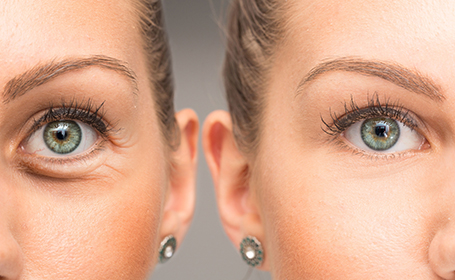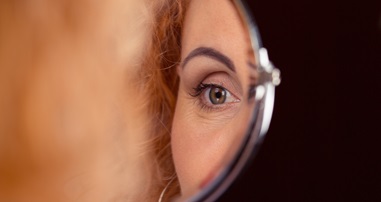
Eyelid Surgery: Your questions answered
We answer common questions on eyelid surgery, also known as blepharoplasty. Covering possible reasons for having the procedure, what's involved, risks and alternative options
What is eyelid surgery (blepharoplasty)?
Blepharoplasty is a surgical procedure to remove excess skin and sometimes excess muscle and fat from your upper eyelids. It is a cosmetic eye procedure and can be performed by various types of surgeons including cosmetic surgeons and eye specialists (including some ophthalmologists).
The more common procedure is upper lid blepharoplasty to reduce the appearance of baggy upper eyelids and to restore a normal/less tired appearance. Lower lid blepharoplasty is much less commonly performed (see complications below).
Blepharoplasty does not improve the 'crow's feet' wrinkles and those between the eyebrows, the dark circles around your eyes or the low position of your eyebrows.
Sometimes the upper lids become so baggy that they cut across the pupil and limit light entering the eye with subsequent reduction in vision.
What are the reasons for eyelid surgery?
The main reason for having blepharoplasty is that it offers you a refreshed and younger looking appearance around your eyes.
Blepharoplasty can reduce skin excess, puffiness caused by protrusion of fat pads and even improve your visual fields in situations where heavy excess skin causes hooding over the eyes. (Sometimes the upper lids become so baggy that they cut across the pupil and limit light entering the eye with subsequent reduction in vision.)
If you are looking to have surgery to remove eye lumps or eyelid lumps and bumps, your surgeon may recommend a different type of surgery or perhaps non-surgical treatments.
What does the procedure involve?
Eyelid surgery can be performed under general anaesthetic (where you are asleep) or local anaesthetic and sedation (you'll be awake but very relaxed and won't feel pain).
The procedure is usually carried out under local anaesthetic (injected into the eyelids - which does sting). General anaesthetic may be preferable in cases where fat pads have to be removed or redistributed, as this can be painful under local anaesthetic.
Surgical time is about an hour, but can vary depending on the complexity of each individual case.

What are the alternatives to eyelid surgery?
There are alternative non-surgical treatments such as the use of peeling, anti-wrinkle injections or laser treatments to improve the wrinkles and skin quality.
There are some forms of laser treatment for less baggy eyelids. If our surgeons feel that you can achieve your goals without operating, then they will recommend non-surgical options. Equally if surgery is the best option for them then they will advise you of this.
Are there any risks or side effects to the procedure?
Any surgical treatment involves certain risks. It is important to understand all the risks associated with the blepharoplasty procedure. Your decision to have this operation should be based on your careful evaluation of all the possible risks and the potential benefits. Most patients undergoing this surgery do not experience complications. However, you should discuss all possible risks and your tolerance of complications with your consultant surgeon, in order to make sure that you fully understand the implications and consequences of having a blepharoplasty.
The main risk from upper lid blepharoplasty is infection, bleeding and bruising. If the surgeon removes too much tissue - this can lead to a poor blink function and corneal exposure. Tissue removed at the time of surgery is stored in saline until the procedure is completed. If the surgeon has any doubts - tissue can be re-grafted into the wound. Lower lid surgery carries a higher risk of bleeding because of disturbance of the fatty tissue around the eye. This bleeding can track towards the optic nerve, leading to pain and potential loss of vision if not diagnosed early enough. Scarring of the lower lids can be very unsightly.
The final result will be seen after 3 months. The scars are usually very well hidden and not easy to see.
How long does it take to recover from eyelid surgery?
After surgery, your eyelids will feel tight and sore and your eyes might be watery or itchy. It's common to be sensitive to light for a while.
When you first wake up you will have slightly blurred vision but this won't last long. Some swelling and bruising is typical for the first three weeks, and may take up to eight weeks to go completely.
Eyelid surgery is usually done as a day-case procedure, meaning you can go home on the same day. You won't be able to drive yourself home and you may need a bit of help when you get there, but after a day or two you should feel almost back to normal.
Your consultant will prescribe antibiotic eye drops while you heal and you may be recommended ice packs to reduce swelling, too. You'll be given detailed instructions on how to care for your eye and look after yourself as you recover from blepharoplasty.
Interested in eyelid surgery?
If you think blepharoplasty is the right procedure for you, give us a call and one of our advisors will help you arrange an initial consultation with a talented specialist near you.
Tags
How do I book an appointment?
If you're concerned about symptoms you're experiencing or require further information on this subject, talk to a GP or see an expert consultant at your local Circle Hospital.